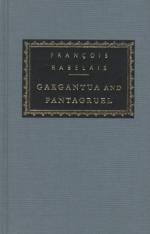The subject is quite different. It is the adventures of Baldo, son of Guy de Montauban, the very lively history of his youth, his trial, imprisonment and deliverance, his journey in search of his father, during which he visits the Planets and Hell. The narration is constantly interrupted by incidental adventures. Occasionally they are what would be called to-day very naturalistic, and sometimes they are madly extravagant.
But Fracasso, Baldo’s friend, is a giant; another friend, Cingar, who delivers him, is Panurge exactly, and quite as much given to practical joking. The women in the senile amour of the old Tognazzo, the judges, and the poor sergeants, are no more gently dealt with by Folengo than by the monk of the Iles d’Hyeres. If Dindenaut’s name does not occur, there are the sheep. The tempest is there, and the invocation to all the saints. Rabelais improves all he borrows, but it is from Folengo he starts. He does not reproduce the words, but, like the Italian, he revels in drinking scenes, junkettings, gormandizing, battles, scuffles, wounds and corpses, magic, witches, speeches, repeated enumerations, lengthiness, and a solemnly minute precision of impossible dates and numbers. The atmosphere, the tone, the methods are the same, and to know Rabelais well, you must know Folengo well too.
Detailed proof of this would be too lengthy a matter; one would have to quote too many passages, but on this question of sources nothing is more interesting than a perusal of the Opus Macaronicorum. It was translated into French only in 1606—Paris, Gilley Robinot. This translation of course cannot reproduce all the many amusing forms of words, but it is useful, nevertheless, in showing more clearly the points of resemblance between the two works,—how far in form, ideas, details, and phrases Rabelais was permeated by Folengo. The anonymous translator saw this quite well, and said so in his title, ’Histoire macaronique de Merlin Coccaie, prototype of Rabelais.’ It is nothing but the truth, and Rabelais, who does not hide it from himself, on more than one occasion mentions the name of Merlin Coccaie.
Besides, Rabelais was fed on the Italians of his time as on the Greeks and Romans. Panurge, who owes much to Cingar, is also not free from obligations to the miscreant Margutte in the Morgante Maggiore of Pulci. Had Rabelais in his mind the tale from the Florentine Chronicles, how in the Savonarola riots, when the Piagnoni and the Arrabiati came to blows in the church of the Dominican convent of San-Marco, Fra Pietro in the scuffle broke the heads of the assailants with the bronze crucifix he had taken from the altar? A well-handled cross could so readily be used as a weapon, that probably it has served as such more than once, and other and even quite modern instances might be quoted.




